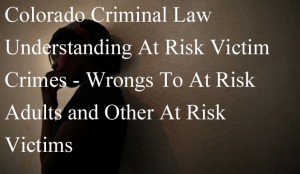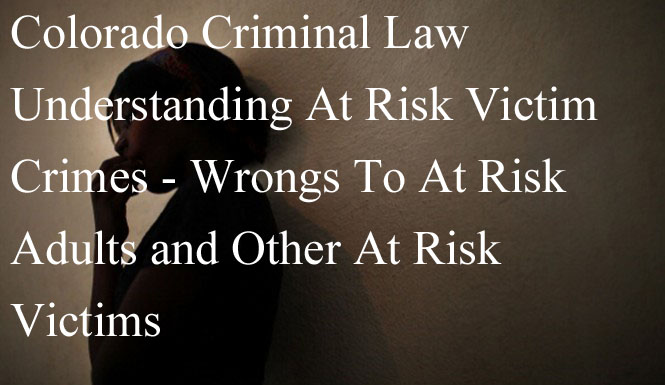






Colorado Criminal Law – Understanding At Risk Victim Crimes – Wrongs To At Risk Adults and Other At Risk Victims – 18-6.5-103
By H. Michael Steinberg Colorado Criminal Defense Lawyer
 Colorado Criminal Law – Understanding At Risk Victim Crimes – Wrongs To At Risk Adults and Other At Risk Victims – 18-6.5-103 Under Colorado law – certain kinds of crimes contain so called “enhancers” that increase the potential level of crime and severity of the penalty. Some of these enhanced crimes require mandatory sentencing – such as sentencing for violent crimes. Others are the enhancers based on the type of alleged victim.
Colorado Criminal Law – Understanding At Risk Victim Crimes – Wrongs To At Risk Adults and Other At Risk Victims – 18-6.5-103 Under Colorado law – certain kinds of crimes contain so called “enhancers” that increase the potential level of crime and severity of the penalty. Some of these enhanced crimes require mandatory sentencing – such as sentencing for violent crimes. Others are the enhancers based on the type of alleged victim.
Colorado crimes against alleged victims who are perceived as particularly vulnerable are classified as crimes against “at risk” victims. They are NOT entirely new crimes – rather they change the penalties and some of the procedures that apply in cases of crimes against at-risk victims.
One exception is 18-6.5-103(6) which provides that:
“any person who knowingly neglects an at-risk adult or at-risk juvenile or knowingly acts in a manner likely to be injurious to the physical or mental welfare of an at-risk adult or at-risk juvenile commits a class one misdemeanor.”
Colorado “At Risk” Victims
Colorado law places the crimes against at risk victims into one Article of the Colorado Revised Statutes. Crimes against an at-risk adults or at-risk juveniles are treated “differently” than when the very same crime is committed against another citizen.
The reason stated for this different treatment is the “status” of the victim. The reasoning for this disparate treatment is found in the following introduction to the laws protecting at risk victims.
18-6.5-101. Legislative declaration.
The general assembly recognizes that fear of mistreatment is one of the major personal concerns of at-risk adults and at-risk juveniles and that at-risk adults and at-risk juveniles are more vulnerable to and disproportionately damaged by crime in general but, more specifically, by abuse, exploitation, and neglect because they are less able to protect themselves against offenders, a number of whom are in positions of trust, and because they are more likely to receive serious injury from crimes committed against them and not to fully recover from such injury.
At-risk adults and at-risk juveniles are more impacted by crime than the general population because they tend to suffer great relative deprivation, financially, physically, and psychologically, as a result of the abuses against them.
A significant number of at-risk adults and at-risk juveniles are not as physically or emotionally equipped to protect themselves or aid in their own security as non-at-risk adults and non-at-risk juveniles in society. They are far more susceptible than the general population to the adverse long-term effects of crimes committed against them, including abuse, exploitation, and neglect. The general assembly therefore finds that penalties for specified crimes committed against at-risk adults and at-risk juveniles should be more severe than the penalties for the commission of said crimes against other members of society.
[HMS – ALL of the statutes addressing at risk victims are reprinted in this article (as of 2015)]
Here is a brief summary of the laws and how they operate under Colorado Criminal Law.
18-6.5-102 Defining Colorado At-Risk Victims
Under Colorado law:
an at risk adult is anyone who is 60 years of age or older and includes any person who is 18 years of age or older with a disability.
an at-risk juvenile is anyone under the age of 18 with a disability.
A person with a “disability” is defined as a person:
who is impaired because of the loss of a hand or a foot or the loss of the use of a hand or a foot; is unable to walk, see, hear, or speak; is unable to breathe without mechanical assistance; is developmentally disabled
who has a mental illness (under 27-10-102(8.5).
who is mentally impaired (under 24-34-301(2.5)(b)(III)
who is blind (under 26-2-103);
or who is receiving care and treatment for a developmental disability.
New Law Protecting At Risk Victims – Mandatory Reporting For Crimes Committed Against 70 Years Of Age Or Older
In May 16, 2013 Governor Hickenlooper signed into law S.B. 111
The new law provides that on and after July 1, 2014 – professionals who are Colorado mandatory reporters:
who observe the abuse or exploitation of a person who is 70 years of age or older (at-risk elder) or
who have reasonable cause to believe that an at-risk elder has been abused
or
has been exploited and is at imminent risk of abuse or exploitation
…. are required to report such fact to a law enforcement agency within 24 hours after making the observation or discovery.
The failure to report any or all of these abuses commits a class 3 misdemeanor.
Once reported to , a law enforcement agency shall notify the at-risk elder’s county department and district attorney’s office of the report.
The law enforcement agency then completes a criminal investigation if they deem it appropriate. After they complete their investigation, the law enforcement agency they report their findings to the at-risk elder’s county department and the district attorney’s office.
A person who reports an incident of abuse or exploitation to a law enforcement agency is immune from a civil action or criminal prosecution if the report was made in good faith.
A person who knowingly makes a false report under this law commits a class 3 misdemeanor crime.
The bill adds physical therapists, emergency medical service providers, chiropractors, and clergy to the list of professionals who are currently urged to report the mistreatment, self-neglect, or exploitation of an at-risk adult.
These professions are also included within the new list of mandatory reporters. A person who exercises undue influence to convert or take possession of an at-risk elder’s money, assets, or other property commits statutory theft.
The Colorado Laws Addressing Wrongs To At-Risk Adults
18-6.5-101. Legislative declaration. (see above)
[HMS – 18-6.5-102 provides important statutory definitions that guide the other at risk laws.]
18-6.5-102. Definitions.
As used in this article, unless the context otherwise requires:
(1) “At-risk adult” means any person who is sixty years of age or older or any person who is eighteen years of age or older and is a person with a disability as said term is defined in subsection (3) of this section.
(1.5) “At-risk juvenile” means any person who is under the age of eighteen years and is a person with a disability as said term is defined in subsection (3) of this section.
(2) “Neglect” has the same meaning as set forth in section 26-3.1-101 (4) (b), C.R.S.
(3) A “person with a disability” means any person who:
(a) Is impaired because of the loss of or permanent loss of use of a hand or foot or because of blindness or the permanent impairment of vision of both eyes to such a degree as to constitute virtual blindness; or
(b) Is unable to walk, see, hear, or speak; or
(c) Is unable to breathe without mechanical assistance; or
(d) Is developmentally disabled as defined in section 27-10.5-102 (11), C.R.S.; or
(e) Is a person with a mental illness as the term is defined in section 27-10-102 (8.5), C.R.S.; or
(f) Is mentally impaired as the term is defined in section 24-34-301 (2.5) (b) (III), C.R.S.; or
(g) Is blind as that term is defined in section 26-2-103 (3), C.R.S.; or
(h) Is receiving care and treatment for a developmental disability under article 10.5 of title 27, C.R.S.
(3.5) “Position of trust” means assuming a responsibility, duty, or fiduciary relationship toward an at-risk adult or at-risk juvenile.
(4) Any subsection, or portion of a subsection, of this section declared to be unconstitutional or otherwise invalid shall not impair the remaining provisions of this section.
[HMS – Section 18-6.5-103 Contains The Enhanced Penalties For Crimes Against At Risk Victims – 18-6.5-103 establishes harsher sentences for crimes committed against at-risk victims.. The classifications of criminally negligent homicide, first degree assault, second degree assault, third degree assault, robbery, sexual assault on a child, sexual assault on a child by one in a position of trust, or sexual assault on a client by a psychotherapist are all increased by one level when committed against an at-risk victim.]
18-6.5-103. Crimes against at-risk adults and at-risk juveniles – classifications.
(1) Crimes against at-risk adults and at-risk juveniles shall be as prescribed in this section.
(2) Any person whose conduct amounts to criminal negligence, as defined in section 18-1-501 (3), commits:
(a) A class 4 felony if such negligence results in the death of an at-risk adult or an at-risk juvenile;
(b) A class 5 felony if such negligence results in serious bodily injury to an at-risk adult or an at-risk juvenile; and
(c) A class 6 felony if such negligence results in bodily injury to an at-risk adult or an at-risk juvenile.
(3) (a) Any person who commits a crime of assault in the first degree, as such crime is described in section 18-3-202, and the victim is an at-risk adult or an at-risk juvenile commits a class 4 felony if the circumstances described in section 18-3-202 (2) (a) are present and a class 2 felony if such circumstances are not present.
(b) Any person who commits a crime of assault in the second degree, as such crime is described in section 18-3-203, and the victim is an at-risk adult or an at-risk juvenile commits a class 5 felony if the circumstances described in section 18-3-203 (2) (a) are present and a class 3 felony if such circumstances are not present.
(c) Any person who commits a crime of assault in the third degree, as such crime is described in section 18-3-204, and the victim is an at-risk adult or an at-risk juvenile commits a class 6 felony.
(4) Any person who commits robbery, as such crime is described in section 18-4-301 (1), and the victim is an at-risk adult or an at-risk juvenile, commits a class 3 felony. If the offender is convicted of robbery of an at-risk adult or an at-risk juvenile, the court shall sentence the defendant to the department of corrections for at least the presumptive sentence under section 18-1.3-401 (1).
(5) Any person who commits theft, and commits any element or portion of the offense in the presence of the victim, as such crime is described in section 18-4-401 (1), and the victim is an at-risk adult or an at-risk juvenile, or who commits theft against an at-risk adult or an at-risk juvenile while acting in a position of trust, whether or not in the presence of the victim, commits a class 5 felony if the value of the thing involved is less than five hundred dollars or a class 3 felony if the value of the thing involved is five hundred dollars or more. Theft from the person of an at-risk adult or an at-risk juvenile by means other than the use of force, threat, or intimidation is a class 4 felony without regard to the value of the thing taken.
(6) Any person who knowingly neglects an at-risk adult or an at-risk juvenile or knowingly acts in a manner likely to be injurious to the physical or mental welfare of an at-risk adult or an at-risk juvenile commits a class 1 misdemeanor.
(7) (a) Any person who commits a crime of sexual assault, as such crime is described in section 18-3-402, sexual assault in the first degree, as such crime was described in section 18-3-402, as it existed prior to July 1, 2000, and the victim is an at-risk adult or an at-risk juvenile commits a class 2 felony.
(b) Any person who commits a crime of sexual assault in the second degree, as such crime was described in section 18-3-403, as it existed prior to July 1, 2000, and the victim is an at-risk adult or an at-risk juvenile, commits a class 3 felony.
(c) Any person who commits unlawful sexual contact, as such crime is described in section 18-3-404 or sexual assault in the third degree, as such crime was described in section 18-3-404, as it existed prior to July 1, 2000, and the victim is an at-risk adult or an at-risk juvenile, commits a class 6 felony; except that the person commits a class 3 felony if the person compels the victim to submit by use of such force, intimidation, or threat as specified in section 18-3-402 (4) (a), (4) (b), or (4) (c), or if the actor engages in the conduct described in section 18-3-404 (1) (g) or (1.5).
(d) Any person who commits sexual assault on a child, as such crime is described in section 18-3-405, and the victim is an at-risk juvenile, commits a class 3 felony; except that, if the circumstances described in section 18-3-405 (2) (a), (2) (b), (2) (c), or (2) (d) are present, the person commits a class 2 felony.
(e) Any person who commits sexual assault on a child by one in a position of trust, as such crime is described in section 18-3-405.3, and the victim is an at-risk juvenile, commits a class 2 felony if the victim is less than fifteen years of age or a class 3 felony if the victim is fifteen years of age or older but less than eighteen years of age.
(f) Any person who commits sexual assault on a client by a psychotherapist, as such crime is described in section 18-3-405.5, and the victim is an at-risk adult or an at-risk juvenile, commits a class 3 felony if the circumstances described in section 18-3-405.5 (1) exist or a class 6 felony if such circumstances are not present.
(8) For purposes of subsections (3) to (7) of this section, commission of the offenses described in said subsections shall include the attempt, solicitation, or conspiracy to commit such offenses.
[HMS – The next section -18-6.5-104 provides that statutory privileges that would otherwise bar certain witnesses from testifying (including the spousal, attorney-client, clergy-parishioner, physician-patient, psychologist-patient, and parent-child privileges) are not available for excluding or refusing testimony in the prosecution for a crime committed against an at-risk victim.]
18-6.5-104. Statutory privilege not allowed.
The statutory privileges provided in section 13-90-107 (1), C.R.S., shall not be available for excluding or refusing testimony in any prosecution for a crime committed against an at-risk adult or an at-risk juvenile pursuant to this article.
18-6.5-105. Preferential trial dates of cases involving crimes against at-risk adults and at-risk juveniles.
Consistent with the constitutional right to a speedy trial, all cases involving the commission of a crime against an at-risk adult or an at-risk juvenile shall take precedence before the court, and the court shall hear these cases as soon as possible after they are filed.
[HMS – The next law – 18-6.5-105 provides that crimes committed against at-risk victims must take precedence before the court, so the cases should be heard as soon as possible after they are filed.]
18-6.5-105. Preferential trial dates of cases involving crimes against at-risk adults and at-risk juveniles. Consistent with the constitutional right to a speedy trial, all cases involving the commission of a crime against an at-risk adult or an at-risk juvenile shall take precedence before the court, and the court shall hear these cases as soon as possible after they are filed.
[HMS – Section 18-6.5-106 provides that a defendant who is convicted of committing a crime against an at-risk victim may be ordered to pay for the victim’s treatment costs and to pay restitution for monetary damages resulting from the crime.]
18-6.5-106. Payment of treatment costs for victims of crimes against at-risk adults or at-risk juveniles – restitution.
(1) In addition to any other penalty provided by law, the court may order any person who is convicted of a crime against an at-risk adult or an at-risk juvenile, as set forth in this article, to meet all or any portion of the financial obligations of treatment prescribed for the victim or victims of such person’s offense.
(2) At the time of sentencing, the court may order that an offender described in subsection (1) of this section be put on a period of probation for the purpose of paying the treatment costs of the victim or victims, which, when added to any time served, does not exceed the maximum sentence imposable for the offense.
(3) If an at-risk adult or an at-risk juvenile has sustained monetary damages as a result of the commission of a crime described in this article against such adult or juvenile, the court shall order the offender to provide restitution pursuant to article 18.5 of title 16 and article 28 of title 17, C.R.S. If, after a reasonable period not to exceed one hundred eighty days, the offender has not, in the opinion of the court, completed adequate restitution, the offender’s probation may be revoked. However, any remaining amount of restitution shall continue to have the full force and effect of a final judgment and remain enforceable pursuant to article 18.5 of title 16, C.R.S.
Summary And Conclusion Colorado Laws And At Risk Victims
Another large and important section of law in this area that is juxtaposed with the criminal law is CRS 26-3.1-101
This section deals with important definitions of what constitutes abuse. For example:
The Definition of Mistreatment:
Mistreatment is ..”the act or omission which threatens the health, safety, or welfare of an at-risk adult, as such term is defined in subsection (1) of this section, or which exposes the adult to a situation or condition that poses an imminent risk of death, serious bodily injury, or bodily injury to the adult.
It includes, but is not limited to:
Abuse which occurs:
Where there is infliction of physical pain or injury, as demonstrated by, but not limited to, substantial or multiple skin bruising, bleeding, malnutrition, dehydration, burns, bone fractures, poisoning, subdural hematoma, soft tissue swelling, or suffocation;
Where unreasonable confinement or restraint is imposed; or
Where there is nonconsensual sexual conduct or contact (as a crime under the “Colorado Criminal Code”)
What Is Caretaker Neglect?
Caretaker neglect which occurs:
when adequate food, clothing, shelter, psychological care, physical care, medical care, or supervision is not secured for the at-risk adult or is not provided by a caretaker in a timely manner and with the degree of care that a reasonable person in the same situation would exercise; except that the withholding of artificial nourishment.
What Is Exploitation?
Exploitation is:
“the illegal or improper use of an at-risk adult for another person’s advantage.”
Colorado Criminal Law – Understanding At Risk Victim Crimes – Wrongs To At Risk Adults and Other At Risk Victims
If you found any information I have provided on this web page article helpful please click my Plus+1 or the Share button below so that others may also find it.
Never stop fighting – never stop believing in yourself and your right to due process of law.
ABOUT THE AUTHOR: H. Michael Steinberg – Email The Author at [email protected] – A Denver Colorado Criminal Defense Lawyer – or call his office at 303-627-7777 during business hours – or call his cell if you cannot wait and need his immediate assistance – 720-220-2277. Attorney H. Michael Steinberg is passionate about criminal defense. His extensive knowledge and experience of Colorado Criminal Law gives him the edge you need to properly handle your case.
You must make a responsible choice for a Colorado Criminal Defense Lawyer – we encourage you to look at our firm. Over the last 40 plus years – H. Michael has mastered nearly every area of criminal law, procedure and trial and courtroom practice and he is passionate about getting you the best result in your case. He has written and continues to write extensively on Colorado criminal law and he hopes this article – – helps you in some small way. H. Michael hopes you found this page helpful – Colorado Criminal Law – Understanding At Risk Victim Crimes – Wrongs To At Risk Adults and Other At Risk Victims.

Other Articles of Interest:
- Colorado Domestic Violence Sentencing – A Change In The Approach To Mandated Domestic Violence Treatment Requirements
- Colorado Felony Sentencing For Crimes Of Violence 18-1.3-406 CRS
- Juveniles Charged as Adults – Direct File – Transfer Hearings – Colorado Juvenile Criminal Defense Laws
- Colorado Sex Offender Evaluations – The Parental Risk Assessment – Child Contact Assessment
- Will I Get Probation In My Colorado Criminal Case?






















